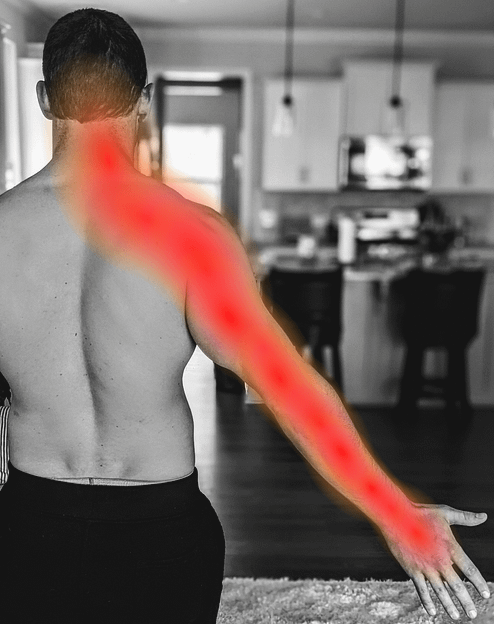One of my PT school professors said this all the time. She meant that:
Muscles do what they’re told.

Muscles are the nervous system’s end-point. The body has muscles like a car has tires. It’s where all the work gets done.
And just like car problems aren’t necessarily caused by tire issues, muscle pain and weakness don’t always stem from muscles misbehaving.
It’s Like a Microwave
Imagine you’re at home, about to sit down to watch a movie. Popcorn crackles in the microwave. Then suddenly, everything shuts off. The lights go out, the TV turns off, and the microwave stops. A few more popcorn kernels pop, then it’s silent.
The power’s out.
So what do you do? Hop on Amazon and order a new microwave?
Of course not. Your microwave isn’t the problem.
Likewise, if you accidentally cook a metal fork in the microwave (let’s be honest, we’ve all been there) and it fries the microwave, you’d chalk it up to user error, not a defective microwave.

Our muscles are like the powerless or malfunctioning microwave.
We fault our muscles for being weak, when the power source is the real problem. Or we abuse our muscles (think poor sitting posture, high stress, training too hard) and blame them for getting sore and developing trigger points.
Treating The Symptoms
Muscles follow orders from the brain and spinal cord.
Muscle tightness and pain are usually symptoms, not the root cause. Sure, muscle treatments like massage and trigger point dry needling work great for short-term pain relief. But the muscle pain will return if the root cause goes untreated.
Here are 3 examples of muscle pain that’s not the muscle’s fault:
1) Pinched Nerve
A pinched nerve in the neck, also called cervical radiculopathy, causes arm symptoms. The C7 nerve root is the most common source of nerve pain from the neck. C7 irritation causes triceps and forearm weakness.

Don’t blame the arm muscles for being painful and weak. Like a microwave without power, there’s not enough electrical signal getting to the muscles to create a strong contraction.
2) Squats and Back Pain
One morning a fellow PT practiced hands-on massage and joint mobilization techniques on my lower back. It felt comfortable.
I had an heavy squat session scheduled that afternoon. By the time I warmed up to my heaviest weight, my back was stiffer than a 2×4. What happened?

Well, my connective tissue is stretchier than average. Medical folks call it “hypermobility,” but it’s colloquially known as being “double-jointed.”
Anyways, the massage and mobility work turned down the muscle tone and relaxed the stability around my spine. When I loaded a few hundred pounds on my back to squat, my brain told ALL my low back muscles to tighten up and stabilize my lumbar spine.
Even though my muscles hurt, it wasn’t their fault. They just followed orders. Instability is one cause of back pain during squats.
3) TMJ Pain
Tight TMJ muscles cause many jaw issues. This muscle tightness can stem from stress, teeth grinding, chewing cheap steak, or holding your jaw open for too long at the dentist.
Effective TMJ treatments include massage, dry needling and heat to soothe the sore muscles. Plus, it’s crucial to address the factors causing the muscle tightness so it doesn’t come right back.
Now What?
Let’s finish up with a few practical tips for dealing with muscle pain:
1. Get to the Source
Muscles rarely go rogue and misbehave on their own. If stretching, massage and percussion therapy don’t provide lasting muscle pain relief, the symptoms may be originating elsewhere.
2. Lighten the Load
Muscle pain happens when we do too much, too fast. Think of a runner who doubles her weekly mileage, or a lifter who tries to hit a 50-lb personal record every week.
Even hunching over an ergonomically incorrect desk puts serious strain on the neck and shoulders. If sitting exacerbates your muscle tightness, check out 5 Ways to Sit with Less Pain.
Bottom line: Smart activity modification is key to recovering from muscle pain.
3. Get Stronger
A strong muscle is a durable muscle. Most PT studies find that exercise is the most powerful pain relief treatment.
Long-term, exercise is more powerful than passive treatments like massage, decompression, spinal manipulation, and dry needling.
The bench press, squat and deadlift are my favorite exercises to train multiple major muscle groups at once. Plus, they build serious resilience and muscle strength.
To read more about the “Big 3” lifts, check out these articles:
10 Tips to Bench Press Without Shoulder Pain
3 Reasons You Have Lower Back Pain After Squats
What Causes Lower Back Pain After Deadlifts?
Readers: How do you handle muscle pain? What are your favorite exercises and pain-relief treatments? Do you focus on the painful spots or do you search for a deeper cause? Let me know in the comments.
For more evidence-based insights you won’t find anywhere else, join the free, fast-growing Facts & Physio Newsletter. Plus, get The Recovery Checklist when you sign up.

